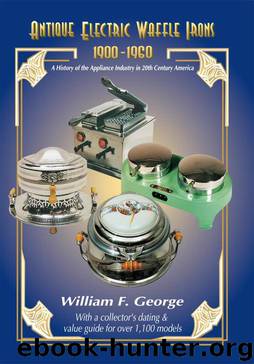Antique Electric Waffle Irons 1900-1960 by William F. George

Author:William F. George [George, William F.]
Language: eng
Format: epub
ISBN: 9781412252676
Publisher: Author Solutions Inc.
Published: 2003-03-18T16:00:00+00:00
“Homelectrics”
Manning Bowman marketed its first electric waffle iron , Model 1605, in the early 1920s. It was the first of several similar models. Excellent heating elements assured fine performance and nice styling produced strong sales. The entire body and tray like most small appliances of this vintage was fabricated from brass and then nickel plated. See the patent drawing and an advertisement for this iron on the next page.
Manning-Bowman Company, one of the first houseswares manufacturers in the United States, was founded in 1849 in Cromwell, Connecticut as Thomas Manning and Son. Manning’s son Thadeus took on a partner, Robert Bowman, in 1864, and the new company was incorporated as Manning-Bowman and Company. The firm produced “Britannia” ware, planished (toughened, polished) tinware, and porcelain enamelware. In 1872, they merged with the Meriden Britannia Company, and moved to Meriden, Connecticut, where they remained for over eight decades.
Over the years, Manning-Bowman became involved in supplying the hotel and restaurant trades with numerous cooking devices, only later adding household cooking items to its product line. Shortly after the turn of the century, the company was one of the first to manufacture electrical appliances for the home. By the teens, they, along with Landers, Frary and Clark, were the leaders in the portable appliance industry, and remained so until after World War II. In 1952, Manning-Bowman was sold to McGraw-Electric, which continued using the Manning-Bowman name into the mid-1950’s.
Manning-Bowman began making electric waffle irons in the early 1920s and apparently was quite successful as evidenced by the large number of early models that have survived. First generation units like the Model 1605 pictured above, have heavy heating wires imbedded in a large thick refractory clay matrix, an effective method of spreading heat evenly over the entire cooking grid. The quality of the materials, plating, and craftsmanship of these early irons is superb and all of the early models work well. The waffle grids on most of the company’s models were designed to create a very thick, Belgian type waffle, with large dimples similar to those made by many cast iron stovetop waffle irons of the day.
Download
This site does not store any files on its server. We only index and link to content provided by other sites. Please contact the content providers to delete copyright contents if any and email us, we'll remove relevant links or contents immediately.
| Furniture | Glass & Glassware |
| Kitchenware | Porcelain & China |
| Rugs |
How to Be a Bawse: A Guide to Conquering Life by Lilly Singh(7397)
Spare by Prince Harry The Duke of Sussex(5078)
Millionaire: The Philanderer, Gambler, and Duelist Who Invented Modern Finance by Janet Gleeson(4386)
Machine Learning at Scale with H2O by Gregory Keys | David Whiting(4200)
Never by Ken Follett(3801)
Harry Potter 02 & The Chamber Of Secrets (Illustrated) by J.K. Rowling(3627)
The Heroin Diaries by Nikki Sixx(3499)
Urban Outlaw by Magnus Walker(3343)
Harry Potter and the Prisoner of Azkaban (Book 3) by J. K. Rowling(3304)
Fairy Tale by Stephen King(3230)
Japanese Design by Patricia J. Graham(3113)
The Man Who Died Twice by Richard Osman(2998)
The Club by A.L. Brooks(2864)
Stacked Decks by The Rotenberg Collection(2812)
Will by Will Smith(2797)
Harry Potter and the Deathly Hallows (7) by J.K. Rowling(2648)
Churchill by Paul Johnson(2512)
The Chimp Paradox by Peters Dr Steve(2303)
Borders by unknow(2232)
